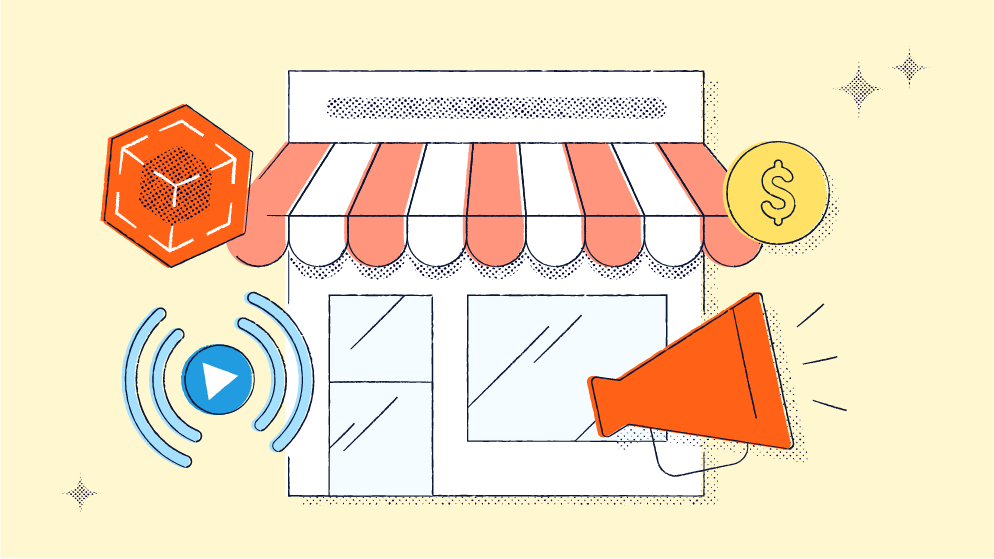
Consumer packaged goods (CPG) brands haven’t had the best past couple of years. Some are losing their must-have status on retail store shelves and in consumers’ lives because of constantly shifting buyer preferences.
How do you weather the storm, continuously attract new customers, and retain existing ones? By keeping an eye on CPG trends and adapting your processes to reflect current customer and market needs.
One top trend to consider is gamification. As brands increasingly scour for ways to boost customer loyalty and retention, gamification has emerged as the secret weapon many didn’t know they needed.
Here, we delve into what gamification means for CPG businesses and guide you on how to implement gamification strategies effectively.
Note: The brands mentioned in this article were found during our online research.
The role of gamification in consumer packaged goods (CPG)
Is gamification a worthwhile endeavor? Definitely! When properly executed, it can help you stand out, remain relevant in the competitive CPG industry, and boost brand loyalty, customer engagement, and brand awareness. Let’s delve into its role in your market:
Brand engagement
Gamification is a game-changer in customer engagement (pun intended). It can create a fun and rewarding shopping experience, keeping your customers coming back for more. Introducing game-like elements like challenges and rewards to your products or processes sparks customers’ adventurous spirits and can lead to more interactive experiences with each other and your brand.
Various companies have successfully used gamification for heightened consumer engagement. For example, Nike’s Run Club app remains one of the most successful health and wellness apps because it features gamification elements like challenges, rewards, and leaderboards. These features not only promote continued user engagement with the app but also social interactions among players.
Nike’s strategy can also work in the CPG industry by bringing excitement to shopping experiences—introduce challenges that allow customers to win rewards like giveaways, discounts, and freebies, and watch as your engagement rates soar!
Sales and product trials
If you want to introduce your target audience to new products or increase the sales of existing ones, gamification can help. It can create a buzz around your products and motivate consumers to try them, more so if you provide incentives. It can also boost engagement by providing a more fun shopping experience. Typically, the more engaged customers are, the more likely they are to make purchases.
L’Oréal has excelled at using gamification for product trials and sales. The brand’s Virtual Makeup Try-On tool uses augmented reality to allow customers to try out different products virtually, bringing excitement to the shopping experience and highlighting products they wouldn’t otherwise consider.
Depending on your type of business, you can implement L’Oréal’s gamification strategy or go for something more common, like a points system, where you award customers points for trying new products—they can then redeem the points for products, coupons, or discounts.
Brand awareness and recall
To survive in the competitive CPG space, you need to enhance brand visibility and recall. This way, consumers can choose your brand whenever they need a product you offer.
Gamification is one of the best solutions, as it helps you stand out and creates memorable experiences, making it easier for customers to notice and remember your brand.
OXXO, a popular retail chain in Latin America, had significant success penetrating the Peruvian market thanks to gamification. The chain launched a digital scratch game, where players needed to find three matching symbols to win prizes. The challenge resulted in over 190 hours of playtime, increased foot traffic in the store, and boosted visibility for OXXO on social media. While OXXO is not in the CPG sector, you can still implement its strategy to raise brand awareness in your industry.
Customer loyalty
You need to do more than just provide high-quality products for customer retention—you must also offer great experiences. Gamification facilitates this by integrating fun, interactive elements into marketing and allowing you to reward ongoing engagement.
If you want to improve customer retention, you can introduce a loyalty program where consumers earn redeemable points for continuously buying your products. This can not only encourage more purchases from existing customers but also attract new customers through positive word of mouth.
Starbucks is the poster child for the impact of gamification on customer loyalty. The brand’s points-based loyalty program rewards customers for their purchases with stars they can redeem for a wide range of gifts, from free drink customizations to free packaged coffee beans. This program has over 30 million active members and is one of the largest contributors to Starbucks’ revenue.
Valuable consumer data
Gamification can facilitate the collection of valuable consumer data, promoting better marketing and overall business decisions. With the right tools, you can introduce your target audience to various gamification elements and assess their engagement rates for insights into consumer preferences and behavior.
Luckily, we know just the right tool for you. Bitly offers various consumer packaged goods solutions, such as QR Codes and branded links, which you can leverage to provide gamified experiences and gain insights into the performance of different strategies. For example, you can use QR Codes to let customers enroll instantly in your loyalty program. Doing so not only enhances convenience but also enables you to see how gamification drives customer engagement, as Bitly tracks all its solutions in real time. Performance data can aid in more targeted marketing efforts, allowing you to maximize engagement.
How to implement gamification strategies in CPG marketing
Ready to experience gamification in CPG marketing? Here’s how to implement gamification initiatives for optimal results:
Think about your goals with gamification
As you’ve read above, gamification can help with numerous marketing goals, including increasing brand loyalty, boosting engagement, driving sales, and collecting data.
Determining what you want to achieve is important since each goal has an ideal gamification strategy and success metrics. For example, if you want to boost customer retention, a suitable approach would be to introduce a rewards program for loyal customers to encourage repeat purchases. And, metrics to assess would include your net promoter score and repeat purchase rate.
Goal setting is vital as it determines the direction of your gamification efforts.
Consider which gamification elements make sense to try
You can incorporate plenty of gamification elements into your strategy, such as points, badges, leaderboards, challenges, or rewards systems. While all of them can be appealing, not all will be ideal for your needs and target audience.
Consider your brand’s objectives and audience preferences when choosing gamification elements to ensure they align. Then, tailor them to create a compelling experience that drives desired actions.
For example, if you want to boost engagement and your research shows that your target audience enjoys a little friendly competition and prizes, you can develop a challenge where players complete specific tasks within a particular timeframe to win rewards.
The beauty of gamification elements is that you can adapt them to meet your needs—the challenges could be business-specific, like completing quizzes about your brand, and the rewards could be free products.
Integrate with your existing marketing channels
To maximize engagement and brand awareness, integrate your gamification strategy into existing marketing channels such as social media, mobile apps, or in-store promotions. Select channels or platforms where your target audience is the most active for maximum exposure.
For example, if you’re already on social networks because that’s where potential customers are, you can run social media contests to supplement your other digital marketing efforts.
Maintain consistency in customer interactions, branding, and messaging across all channels for a unified customer experience and to reinforce your brand identity. This consistency can build familiarity and trust, maximizing the impact of gamification efforts.
Ensure scalability and flexibility
The success of any CPG marketing strategy is contingent on a proper understanding of and adaptation to changing consumer behaviors and preferences. As such, your gamification strategies should be scalable and flexible to accommodate growth and changes in consumer behavior.
Leverage technology platforms that allow for easy updates and expansions of gamification features to ensure you always match consumer preferences and needs. With Bitly, you never have to worry about outgrowing your platform—you can scale your solutions and tracking capabilities as your business evolves to meet customer needs and continue gaining valuable insights.
Track and optimize the results
Tracking and analyzing results helps you understand what’s working and what needs improvement, allowing you to optimize your results. Some key performance indicators (KPIs) to keep an eye on are:
- Engagement rate: This measures the number of people engaging with your gamification elements.
- Task completion rate: The rate at which challenge respondents complete tasks. It can help you determine if your gamified experience is engaging enough or user-friendly.
- Conversion rate: This is the rate at which potential customers convert into customers after interacting with your gamification elements.
- Net promoter score: This measures customer satisfaction and the likelihood they’ll recommend your brand.
- Return on investment (ROI): The ratio between the financial returns generated from your gamification strategy and the costs of planning and execution. It can help you determine whether you’re getting value or simply losing money.
Leverage tools like Bitly for seamless performance tracking and results optimization. With Bitly Analytics, you can see the number of people clicking links or scanning QR Codes to access gamification experiences. This data can help you identify gamification tactics that work, allowing you to improve your strategy and focus your resources on initiatives that help you meet business objectives effectively.
Best practices for creating gamified experiences in CPG
Gamification can boost customer interactions, drive sales, and bring you closer to achieving whichever goals you have in mind. However, this is all contingent on how effective and well-designed your CPG gamification experiences are. So, don’t just throw gamification elements together; take time to develop a well-thought-out strategy. Here are some best practices to guide you:
- Create experiences with your target audience in mind.
- Align your gamification experience with overall marketing goals.
- Focus on simplicity, clarity, accessibility, and security.
- Use cross-platform integration.
- Encourage social sharing among customers.
- Leverage technology for seamless execution.
- Continuously measure and optimize digital experiences based on performance data.
Use Bitly to make your CPG gamification a success
The level of competitiveness in the CPG sector calls for innovative solutions like gamification. When properly executed, gamification can drive brand awareness, engagement, and loyalty, ultimately increasing revenue.
Consider your audience’s preferences and business goals when designing gamified experiences for the best results. Also, use scalable technology like Bitly and regularly measure the effectiveness of gamification efforts for continuous improvements.
With Bitly’s link management and analytics tools, you can track the success of gamified campaigns from a centralized platform. Bitly’s short links and QR Codes provide real-time data on customer interactions with gamified content, enabling you to measure engagement, adjust strategies promptly, and optimize outcomes.
Sign up for Bitly today to elevate your brand’s engagement and sales with effective, trackable CPG gamification solutions!



